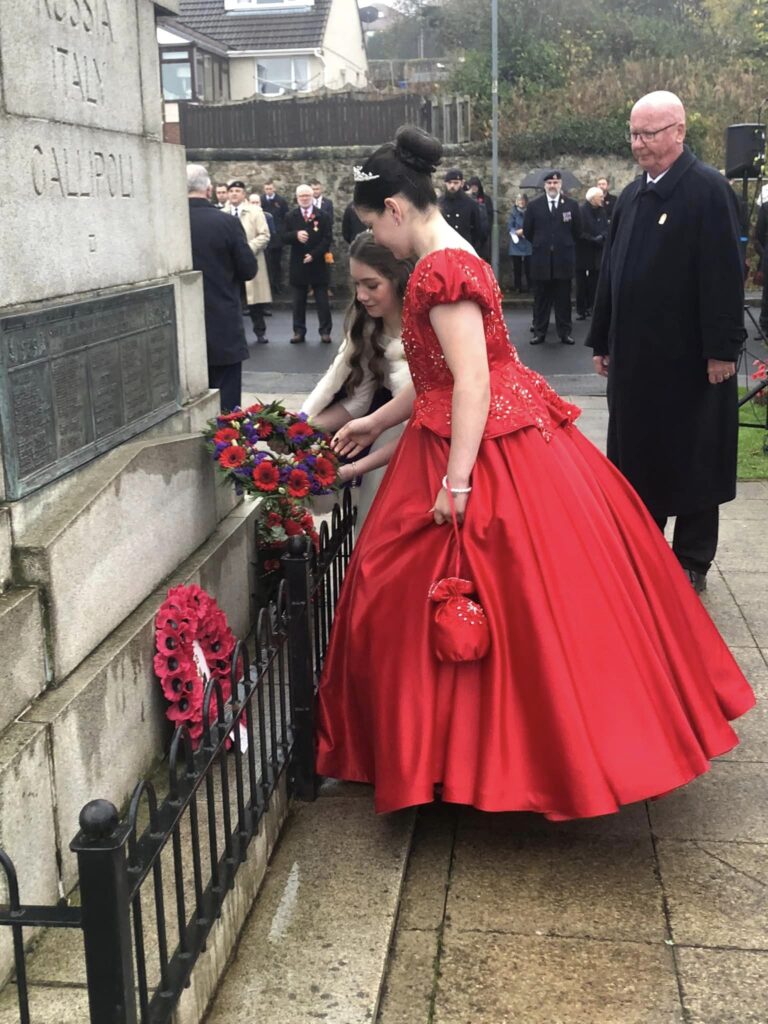“There was great excitement at 41 South Street yesterday,” reported the Bo’ness “Journal” of Friday, 11th April, 1952, and then went on to give the reason.
“For 11 year old, Myra Taylor ran home to tell her parents that she had been elected this year’s Bo’ness Fair Queen by her fellow classmates in the Qualifying class at the Public School.”
The Public School pupils’ choice of Myra to be our 1952 Fair Queen was an especially popular one the “Journal” went on to inform its readers, because in addition to her being, “a pretty complexioned lass with attractive light brown hair,” she was even more importantly “the first real ‘town’ Queen for several years,” and already the first ever arch across South Street was being planned.
For a moment, however, it looked as if South Street might be robbed of its big day, because rumours soon spread that Queen Myra’s family were about to be offered a Council house in the new Maidenpark Housing Scheme. Mrs Taylor swiftly reassured her neighbours that no matter what the attractions of Maidenpark, the family would most certainly not depart for the back of beyond, as Maidenpark was then regarded, until after Myra had been safely crowned.
The expansion of Bo’ness far past Maidenpark to the even more ratified heights of Deanburn, Jessfield and Borrowstoun, is by no means the only change to have occurred in our old town, by the Forth, during the 25 years, which have slipped away since Queen Myra and our nation’s monarch, Queen Elizabeth, both came to the throne in 1952, as is clearly shown by both the adverts and editorial content of that rather crumpled, rather tattered four page, large sheet, old style “Journal” which Willie Broome so painstakingly edited and printed in his wee office in North Street.
While the Fair Committee met under the convenership of that well-known figure Bailie Robert Baptie, to deliberate on whether the procession route should be altered to take it along South Street past the Queen’s house and whether they dared increase the cost of the programme to a whole shilling to keep up with the ever rising cost of living, more and more Bo’nessians were glued to the new fangled “telly,” which had come to Scotland and Bo’ness exactly one month before, with the opening in March of the new Kirk O’ Shotts transmitter.
There was of course only one programme and that in black and white, but the excitement that these first T.V. programmes caused in Bo’ness was enormous. MacFarlane and Bell, Aitkman and the Co-operative Society all advertised the latest Bush, H.M.V. and Ferguson 12 and 18 inch sets while Alexander Stores went to the unprecedented lengths of keeping their North Street showroom open until 10.30 p.m. so that local people could come in and spend the evening watching the new wonder. So great were the crowds that tickets had to be issued and many people brought vacuum flasks and sandwiches, so that they could make a real night of it.
The arrival of television in Bo’ness did not, however, make such an impact as to lessen demand for tickets for the “Opera” and on the Monday morning when booking opened, enthusiasts started queuing in Hope Street at 5.30 a.m. waiting for the box office to open at nine, The “Opera” in 1952 was “Rose Marie” and with such favourites as “The Indian Love Call,” “March of the Mounties” and ” Only A Kiss,” it did indeed prove to be a popular success.
Elizabeth Snedden played the title role of “Rose Marie la Flamme,” opposite David Cunningham’s big Jim Kenyon, with Jimmy Burnett, former Fair Queen Helen Burnett, Charlie Frank, Douglas Snedden, Sydney King, Sybil Muir, John F. Miller, Mary Hawthorn and Dan Bennie in the other name parts. Highlight of the show, which played to capacity houses in the Town Hall, was the ” Totem Tom Tom ” dance routine and Bo’ness audiences all agreed that it was every bit as spectacular as in the Hollywood film version.
Films did, of course, continue to do big business at both the Hippodrome and the Star, with bingo still an unknown threat and the big films, which Queen Elect Myra may well have gone to see in the joyful homework free months between the dreaded “Qualifying Exam” and her Coronation, included James Stewart in Nevil Shute’s “No Highway,” Clifton Webb in “Mr Belvedere Rings the Bell” and Anthony Steele in “Where No Vultures Fly.”
Musicals seem to have been especially popular in 1952 with film versions of “Annie Get Your Gun” starring Howard Keel, “Showboat” starring Katherine Grayson, and Doris Day in “Tea for Two,” while for those willing to pay their 1/6 return in the bus to Falkirk, the Regal, now the ABC, offered the chance to see the same blond dynamic star in her latest hit, “Lullaby of Broadway.”
For those really interested in musicals, however, the big news of 1952 was the opening at Drury Lane, London of the big new American smash hit, “South Pacific,” in which Mary Martin nightly “Washed That Man Right Out of Her Hair.” With show stopping songs like that and “Some Enchanted Evening,” it was hardly surprising that the members of Bo’ness Amateur Operatic Society looked forward eagerly to the time when it would become available for staging in the town. This year many local people will delight in recalling these “Enchanted Evenings,” when members of the original cast along with lots of the town’s present younger generation come together specially to mark Jubilee Year and at the same time boost Fair funds, by restaging “South Pacific” in the Town Hall, from Monday, 28th November, to Saturday, 3rd December.
Back in 1952 requests for “Bali Hi” and “Younger Than Springtime” flooded in to “Housewives’ Choice” and “Forces Favourites” on the Light Programme, while on the Scottish Home Service, Bo’ness listeners were able to tune in to their own local favourites, Bo’ness and Carriden Band, who received great praise for their radio performance.
Bo’ness and Carriden, Kinneil, the Salvation Army, and the Pipe Band were among the six bands booked by Fair Festival Director, Mr Beattie for the 1952 Fair, but the Fair Executive Committee faced an unexpected set back when the Secretary, Mr A. Grant announced that he would miss the big day, because he had been called back to do his compulsory army training.
Other reminders that 1952 was not so long after the War come from the “Journal” adverts, reminding Bo’nessians how to claim their new ratio books, while the Co-op was offering a special purchase of ladies dresses.
As May gave way to June the other drapers in the town, Douds, Wevlings, and Griffith & Oliver all began advertising “Fair” specials, including white gloves for only 3/3, girls’ summer dresses for 11/6 and gents’ sport shirts, for the big day, at the bargain price of 9/11.
An early touch of Fair festivity was brought to the town, when the German cargo vessel M.S. “Else Muller” arrived at the dock dressed overall to mark the completion of her maiden voyage across the North Sea to the Forth.
Other visitors to the town were racing drivers of international repute, who came to compete in the R.A.C. British Hill Climb Event at Kinneil. Unfortunately that event on Saturday, 28th June, was marred by the death of driver Ian Struthers, whose car hit the banking at the notorious Snake Bend and rolled over on top of him.
Drivers of a much more cautious kind volunteered their assistance to start a Meals On Wheels service for the first time for old folks of the town. At the opposite end of the age scale many of the youngsters of Bo’ness were fully occupied during these first days of July, 1952, rehearsing for the Academy end of term closing concert, for holidays came later in those days. Urged on by Rector Andrew B. Dea, I well remember practising my party piece, “Cool Clear Water,” the climax of which was the drenching of me at each and every performance.
On the final night, 15th July, the Academy welcomed one of our town’s distinguished sons, former Moderator of the Church of Scotland, the Very Rev. Dr W. White Anderson, who in the crowded old assembly hall, now the girls’ gym, presented prizes, including the silver and gold dux medals to May Moodie and Bill Braid.
Wearing their black academic gowns and their hard won Hope medals on distinctive Bo’ness Academy red, black and gold ribbons also led their school fellows to the Glebe Park on the Fair Morning, where official commentator, Johnie Collee, summoned up a special cheer for them as they marched down towards the platform. With the Academy in position all that remained was for Mr Collee to welcome Queen Myra’s retinue to the arena packed with a capacity crowd of almost 20,000 and no-one could doubt from which school they came from in 1952, for Headmaster Bob Robertson had made sure that all ladies in waitings’ accessories were in distinctive Public School scarlet, and the flower girls’ baskets were filed with vivid red carnations.
Every touch of colour was welcome on that Fair morning, in 1952, for ominous grey clouds drifted in over the Forth, but it remained dry as the hands of the big Town Hall clock swept up towards 11 o’clock and Queen Myra was safely crowned. Then Mr Collee introduced the young presentees. First came Queen of the Flower Girls. Margaret Harris, and Queen of the Fairies, Annette Learmonth, followed by “Take Your Partners” from the Public, Barn Yard Capers from little Borrowstoun School, for whom Balfour Paton created one of the first of his famous tableau, Tulips and Heather from Blackness, David and Goliath from St Mary’s Willow Pattern from Kinneil, and Eastern Dancers from Grange, where Mr Ritchie, now our Fair Secretary, was enjoying his first Fair as Headmaster.
From the Glebe Park, the procession made its way down the Wynd with Provost Haney in the first of the official cars, and turned into the town, passed the shows in Corbiehall and Seaview Place, into South Street and under Queen Myra’s arch, which even without its crown which was damaged in a fall, won first prize over the other two arches at Newtown and Gladstone Terrace, where a new style was introduced with a turreted “castle” designed instead of the traditional green box wood.
Once the procession had passed, many of the crowd rushed off to enjoy strawberries and ice cream at Serafinis or a complete lunch, for only 4/6, at the Coffee House, and they were just in time, for suddenly the clouds turned from grey to black and the rains fell and fell to such an extent that the revels and sports scheduled for the Academy Park had to be cancelled and gave many of the children the excuse to enjoy the matinees at the Hippodrome and the Star where the big films were “Cave of the Outlaws” and “My Friend Irma Goes West” starring Dean Martin and Jerry Lewis.
By evening the rain had ceased and the crowds were able to enjoy a visit to the shows and stroll to see the arches, including the Queen’s, which was beautifully illuminated.
Thus Queen Myra’s day of glory drew to a close. She had lived up to everyone’s expectations and made a truly regal “town” Queen. Now 25 years later it is hoped that she and all the other Bo’ness girls who have reigned since will return to share again in the excitement of this our special Jubilee Fair.
UNKNOWN






